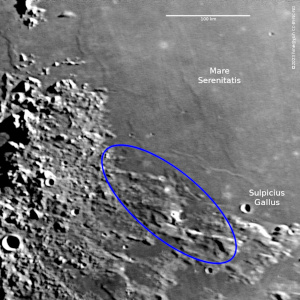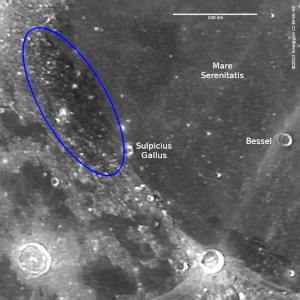
{
Practical astronomy
|
Astronomy
|
The Moon
|
The physical Moon
|
The Lunar 100
}
Lunar #71: Sulpicius Gallus dark mantle
This object is not trivial to identify, mainly because the Lunar 100 list is a bit unclear or misleading. As usual, the data in the list (position, size, best day to observe) are simply taken from the crater that gives the name. But the entry in the Lunar 100 list reads "Sulpicius Gallus dark mantle – ash eruptions northwest of crater" (Wood 2004a, 2012a).
There is no dark spot of similar size near the crater. His notes from the Stargazers' Lounge (Hardwick 2013a) are more extensive, but can be interpreted to speak mostly of other objects in the region.
This sort of object is not well identified in the Atlas virtuel de la Lune (Chevalley and Legrand 2012a) and so one has to find the definition of the object in the research literature. The outline of "Sulpicus Gallus deposits region", the object that Wood seems to have in mind, is shown in their figure 1 by Kumaresan and Saravanavel (2022a).
Dark mantle deposits cover the older lunar surface in some places. They extend across the border between highlands and maria. (Head 1974a). This is what confuses the average ticker-offer of Lunar 100 objects: The area in question here is offset from the crater; it is much larger than the crater, which was merely convenient to provide a name; and it transcends the border between Mare Serenitatis in the Northeast and Montes Haemus in the Southwest. This object is not so easy to distinguish from the Mare Serenitatis dark edges (Lunar 18), because it is essentially the same thing, only at the darker end of the brightness scale.
Dark mantle deposits are albedo features that have no contours to cast shadows, only a brightness difference to the surroundings. Hence, they may be better seen when they are some distance from the terminator instead of close to it. On the other hand, the distinction between highlands and maria is clearer when there are shadows and the terminator is not far.
Images:
- The area imaged on 2023-05-27, stacked from 978 video frames taken with a Schmidt-Cassegrain reflector of D = 200 mm and f = 3500 mm and Canon EOS 600Dα camera. Wavelet sharpening. The phase was +52% (First Quarter). Sulpicius Gallus is the small, prominent crater just inside Mare Serenitatis.
- Dto. with scale, and the approximate area of dark deposits marked by the blue ellipse, which encompasses Rimae Sulpicius Gallus in the mare, but mostly the highland region Montes Haemus south of the crater.
- The area imaged on 2022-10-12, stacked from 863 video frames taken with a Schmidt-Cassegrain reflector of D = 200 mm and f = 3500 mm and Canon EOS 600Dα camera. Wavelet sharpening. The phase was −94% (just past Full Moon). Sulpicius Gallus is the small, bright ring left of centre. On the right margin is the crater Bessel, well inside Mare Serenitatis. Toward the bottom margin are Manilius (bottom left corner) and Menelaus (toward the right).
- Dto. with scale, and the approximate area of dark deposits marked in blue.




